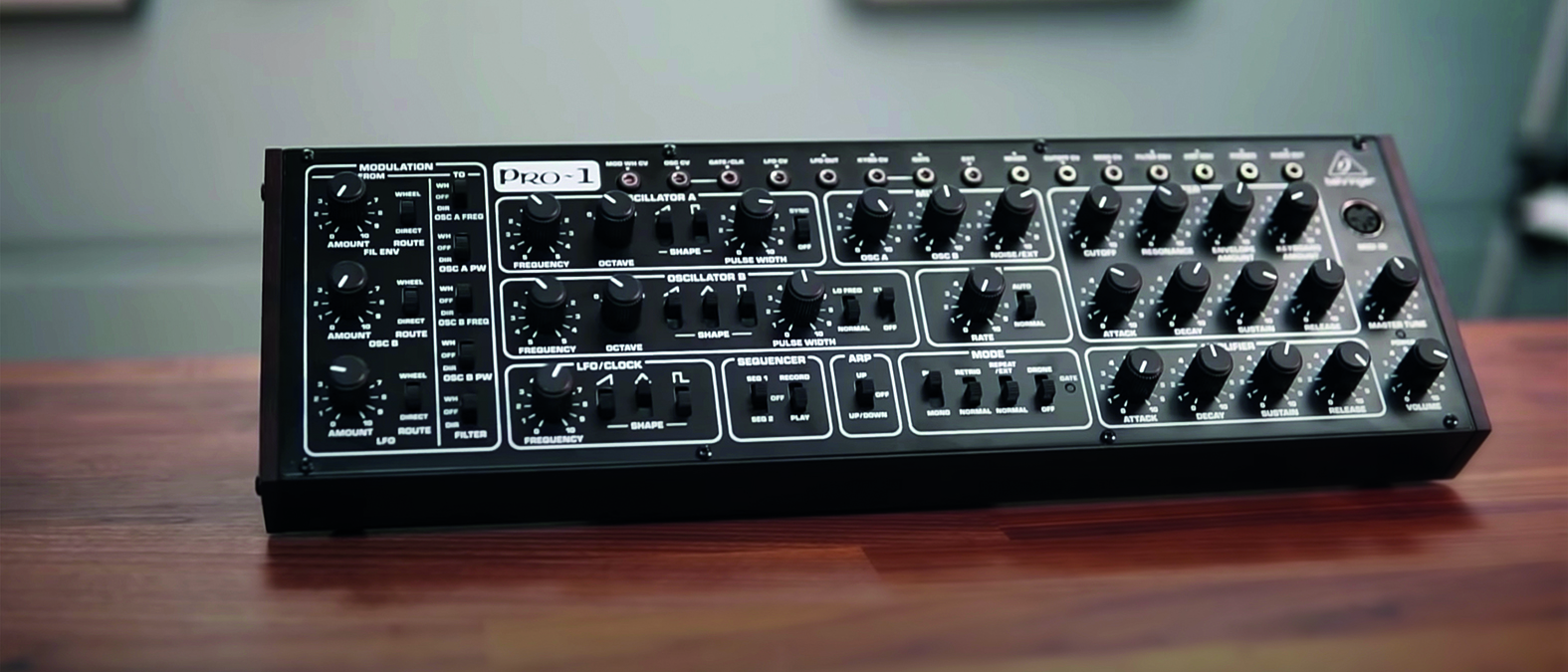MusicRadar Verdict
If you're looking for a rip-roaring monosynth, it’s hard to not wholeheartedly recommend the Pro-1.
Pros
- +
Behringer’s superlative Pro-1, can go from vintage to gnarly in seconds.
- +
Eurorack patch points and mountable design will make a lot of users happy.
- +
Sequencer and arpeggiator, although minimal, are still nice additions.
- +
Small tabletop format means it can slide into almost any studio setting.
Cons
- -
Early units were very in need of tuning calibration when sent from the factory.
- -
No saving of presets at all.
MusicRadar's got your back
Behringer Pro-1: What is it?
Following the release of its own take on the Model D, Behringer’s Pro-1 is an all-analogue tabletop synth that takes inspiration from a certain classic by Sequential Circuits, the Pro-One.
Originally released in 1980, the Pro-One was said to be inspired by a single voice from the iconic Prophet-5 synth, but it had a few tricks of its own. Behringer didn’t mess with the successful formula too much, as its Pro-1 is an all-analogue monosynth that features two oscillators, a beefy filter with its own ASDR envelope, a subtly complex modulation matrix, and a simple sequencer/arpeggiator.
Behringer hasn’t messed with the successful formula too much
Looking at the architecture of Behringer’s Pro-1, you’ll see that not much has changed from the synth that inspired it. There are two oscillators, the first of which offers sawtooth and square waves, with a variable pulse width of the square wave. There’s a four-octave range for each oscillator, as well as a fine-tune knob for those slightly detuned sounds. The second oscillator also has sawtooth and square waves, but adds a triangle wave into the mix as well, which adds a nice warm, subby flavour to the Pro-1’s sound.
Behringer Pro-1: Performance and verdict
Each waveform can be turned on individually for each oscillator, so there’s quite a bit of timbral complexity available before the signal even gets to the filter. Each oscillator has its own level knob in the mixer section, and there’s also a separate white noise generator. When an audio signal is plugged into the external audio jack on the front panel, that knob becomes a volume for that source. Oscillator 1 can be synced to Oscillator 2 for those classic tearing/ripping sounds that you’d associate with many classic ’80s synth riffs.
The Pro-1’s 4-pole low-pass filter is the main attraction here for many, as it sounds great when both open and almost completely closed, giving it a lot of flexibility. Given that the filter has its own ASDR envelope, it’s possible to create sounds that similar synths like the Roland SH-101 just can’t reproduce. The Pro-1’s filter can also self-resonate and act as a sine wave oscillator, allowing it to be a third oscillator.
One area where Behringer has improved over the original is the new duophonic ability of the Pro-1. Each oscillator can be triggered to play a separate pitch by flipping up the somewhat strangely labeled “Poly” switch on the front panel, though both oscillators share the same envelope and filter settings. Setting the Glide to Automatic, as opposed to Normal mode, allows for legato sounds when several notes are held down at once.
Making sense of the modulation matrix
The Pro-1’s modulation matrix is where much of the heavy lifting gets done. Sources range from the Filter envelope, the LFO, and Osc B; each can be routed to five destinations (both oscillators’ pulse widths and frequencies, as well as the cutoff of the filter). Impressively, you can route the sources to each destination either directly or via the Mod wheel, giving a lot of room to modulate your sound. The Pro-1 can also be used with external LFOs and envelopes in your Eurorack case for a very flexible synth voice.
Want all the hottest music and gear news, reviews, deals, features and more, direct to your inbox? Sign up here.

Original is best?
Further improvements over the original include the fact that the Pro-1 can now be used with MIDI, as it has both full-size DIN jacks and a USB MIDI connection which effectively functions as MIDI interface. As mentioned, the Pro-1 also features Eurorack-compatible patch points on the top of the front panel. It’s also possible to remove it from the case and use it in your Eurorack case, with power coming from your power source.
Just like the original, the Pro-1 gives users the ability to store two sequences, each of which can be up to 40 notes. These are retained in memory even after shut-off. Programming in notes is a bit archaic but it works fine. The arpeggiator is identical as well, with just two choices (up and up/down) and no ability to change octave range.
And just like our Model D, our Pro-1 came to us out of the box with some tuning issues. Oscillator 2 didn’t track properly across, even an octave, and the oscillators were set to two totally different pitches with both pitch knobs set to noon. Opening up the unit and tweaking two internal calibration knobs fixed both of these problems, but it did take a bit of fine-tuning to get right.
MusicRadar verdict: If you're looking for a rip-roaring monosynth, it’s hard to not wholeheartedly recommend the Pro-1.
Behringer Pro-1: The web says
"It may be budget in some areas, but sonically this is the real deal, and it consistently made us smile while playing. Behringer has taken great care to get it sounding as close to the original as possible."
MusicTech
Behringer Pro-1: Hands-on demos
Behringer
loopop
Starsky Carr
Andertons Synths, Keys and Tech
Behringer Pro-1: Specifications
- KEY FEATURES: Analogue synth with Dual VCOs, Pure analogue signal path based on authentic VCO, VCF and VCA designs, Classic 4-pole filter design with self-resonance capability, 64-note dual sequencer, 16-voice Poly Chain allows combining multiple synthesisers for up to 16 voice polyphony.
- CONTACT: Behringer
